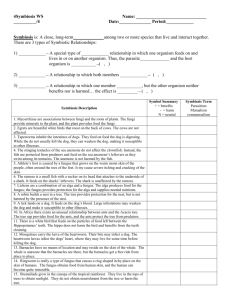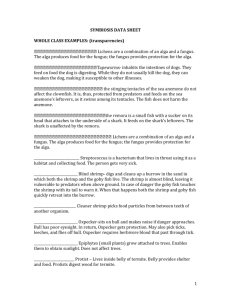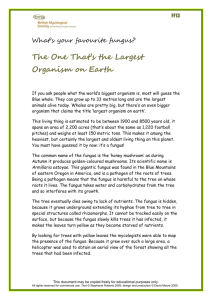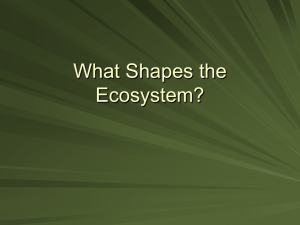BONUS WORK for ecology test KEY
advertisement
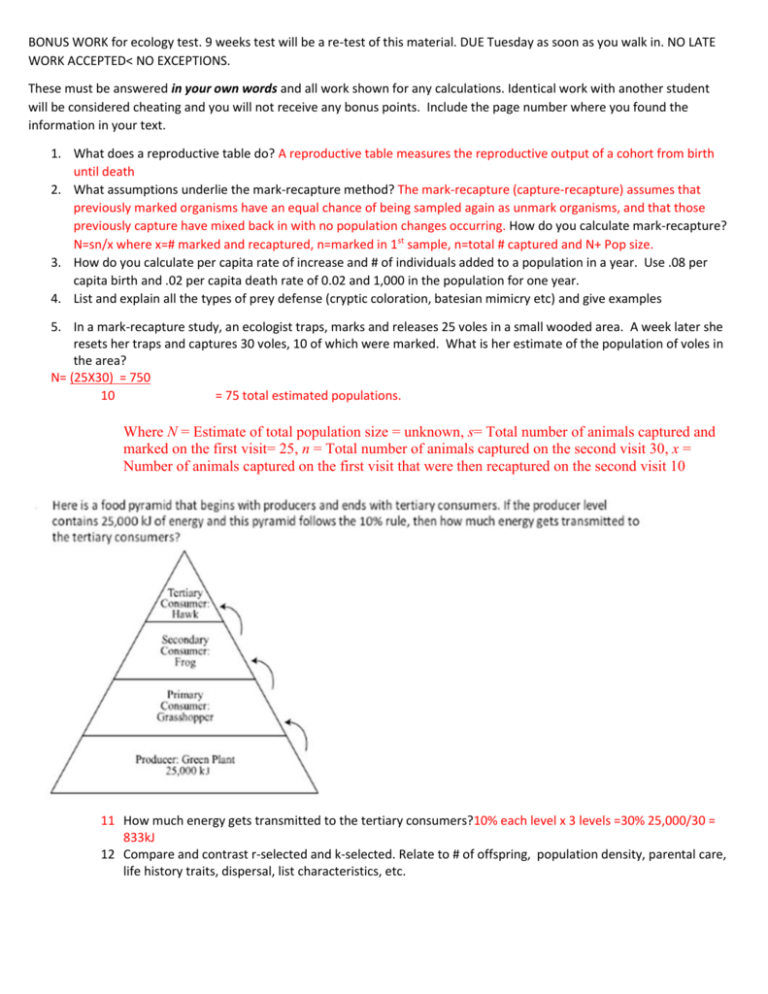
BONUS WORK for ecology test. 9 weeks test will be a re-test of this material. DUE Tuesday as soon as you walk in. NO LATE WORK ACCEPTED< NO EXCEPTIONS. These must be answered in your own words and all work shown for any calculations. Identical work with another student will be considered cheating and you will not receive any bonus points. Include the page number where you found the information in your text. 1. What does a reproductive table do? A reproductive table measures the reproductive output of a cohort from birth until death 2. What assumptions underlie the mark-recapture method? The mark-recapture (capture-recapture) assumes that previously marked organisms have an equal chance of being sampled again as unmark organisms, and that those previously capture have mixed back in with no population changes occurring. How do you calculate mark-recapture? N=sn/x where x=# marked and recaptured, n=marked in 1st sample, n=total # captured and N+ Pop size. 3. How do you calculate per capita rate of increase and # of individuals added to a population in a year. Use .08 per capita birth and .02 per capita death rate of 0.02 and 1,000 in the population for one year. 4. List and explain all the types of prey defense (cryptic coloration, batesian mimicry etc) and give examples 5. In a mark-recapture study, an ecologist traps, marks and releases 25 voles in a small wooded area. A week later she resets her traps and captures 30 voles, 10 of which were marked. What is her estimate of the population of voles in the area? N= (25X30) = 750 10 = 75 total estimated populations. Where N = Estimate of total population size = unknown, s= Total number of animals captured and marked on the first visit= 25, n = Total number of animals captured on the second visit 30, x = Number of animals captured on the first visit that were then recaptured on the second visit 10 11 How much energy gets transmitted to the tertiary consumers?10% each level x 3 levels =30% 25,000/30 = 833kJ 12 Compare and contrast r-selected and k-selected. Relate to # of offspring, population density, parental care, life history traits, dispersal, list characteristics, etc. K-selection r-selection Live around K Exponential growth High prenatal care Little or no care Low birth numbers High birth numbers Good survival of young Poor survival of young Density-dependent Density independent near limit imposed by resources, competition is strong Often found in disturbed habitat ie. Humans, mature trees growing in an old growth forest ie. Cockroaches, weeds growing in an abandoned field 13 Explain fundamental niche vs realized niche a fundamental niche is the biotic and abiotic factors in an organism’s environment. Sometimes a species may only occupy a portion of this nice, called the realized niche, due to competition. 14 Explain what resource partitioning is resource partitioning occurs when 2 or more species share resource in their niche and adapt by splitting the resources in a variety of wats such as limiting the space or alternating times, etc. 15 What do food chains measure? Food chains measure the amount of energy transferred between tropic levels and show which organism feeds on which 16 What is a trophic level? What is level 1,2,3 and 4? A trophic level is the position an organisms occupies in a food chain. Level one would be primary producers, 2 consumers, 3-secondary consumers 4 ternary consumers. 17 Describe 2 hypothesis that explain why food chains are usually short, and state a key prediction of each hypothesis 1. The energetic hypothesis suggest that the length of a good chain is limited by the inefficiency of the transfer between organisms. 10% is approx.. transfer through each level. It predicts that in habitats with high photosynthesis rates, the chains should be larger because the chain starts with a greater amount of energy. 2. The dynamic stability hypothesis states that long food chains are less table than short because population changes at the lower levels and increase at higher levels contributing to extinction of top predators. Predators must be able to recover from traumatic events such as environmental issues like extreme winters. These challenges reduce the food supply, the longer the chain is, the more dramatic the effect of the environmental issue. 18 What does a food web show? Food webs show the interconnectedness of feeding relationships ina comunity 19 What factors define the ecological life history of a species? Traits that affect the reproductive cycle and survival of an organisms. 3 main variables are age of reproduction, frequency of reproduction and offspring produced per episode of reproduction. 20 What is ecological succession? The gradual replacement and colonization of an area previously disturbed Differentiate between primary succession and secondary succession primary succession occurs where soil has not formed and must start with autotophic prokaryotes and heterotrophic prokaryotes and protists in order to guild up the soil. Secondary succession occurs where the soil is intact and is colonized by herbaceous species and windblown/animal borne species. 21 How does a disturbance relate to succession? A disturbance is what clears the ecosystem or changes the community by removing previous organisms and resources. What are some examples of disturbances? Fire, drought, floods, human activity, over grazing, over farming, volcanic eruption, glacier etc. Parasitism-- A relationship in which one organism feeds on and lives in or on another organism. The parasite benefits and the host organism is harmed Mutualism-- A relationship in which both members benefit Commensalism--A relationship in which one member benefits, but the other organism is neither benefit nor harmed Symbiosis Description 1. Mycorrhizae are associations between fungi and the roots of plants. The fungi provide minerals to the plant, and the plant provides food the fungi. Symbol Summary + = benefits - = harm N = neutral (+,+) Symbiosis Term Parasitism Mutualism commensalism M 2. Egrets are beautiful white birds that roost on the back of cows. The cows are not affected. (+,-0) C 3. Tapeworms inhabit the intestines of dogs. They feed on food the dog is digesting. While the do not usually kill the dog, they can weaken the dog, making it susceptible to other illnesses. (+,-) P 4. The stinging tentacles of the sea anemone do not affect the clownfish. Instead, the fish are protected from predators and feed on the sea anemone’s leftovers as they swim among its tentacles. The anemone is not harmed by the fish. (+,+) M 5. Athlete’s foot is caused by a fungus that grows on the warm moist skin of the people, often around the toes of the feet. It my cause severe itching and cracking of the skin. (+,-) P 6. The ramora is a small fish with a sucker on its head that attaches to the underside of a shark. It feeds on the sharks’ leftovers. The shark is unaffected by the ramora. (+,-0) C 7. Lichens are a combination of an alga and a fungus. The alga produces food for the fungus; the fungus provides protection for the alga and supplies needed nutrients. (+,+) M 8. A robin builds a nest in a tree. The tree provides protection for the nest, but is not harmed by the presence of the nest. (+,-0) C 9. A tick lands on a dog. It feeds on the dog’s blood. Large infestations may weaken the dog and make it susceptible to other illnesses. (+,-) P 10. In Africa there exists an unusual relationship between ants and the Acacia tree. The tree sap provides food for the ants, and the ants protect the tree from predators. (+,+) M 11. There is a white bird that feeds on the particles of food left between the Hippopotamus’ teeth. The hippo does not harm the bird and benefits from the teeth cleaning. (+,+) M 12. Mosquitoes carry the larva of the heartworm. Their bite may infect a dog. The heartworm larvas infect the dogs’ heart, where they may live for some time before killing the dog. (+,-) P 13. Barnacles have no means of location and may reside on the skin of the whale. The whale is unaware that the barnacles are there, but the barnacles get a free ride from place to place. (+,-0) C 14. Ringworm is really a type of fungus that causes a ring shaped itchy place on the skin of humans. The fungus obtains food from human skin, and the human can become quite miserable. (+,-) P 15. Bromeliads grow in the canopy of the tropical rainforest. They live in the tops of trees to obtain sunlight. They do not obtain nourishment from the tree or harm the tree. (+,-0) C
